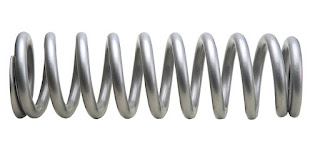Spring History
ü Spring History
Like most other basic mechanisms, metal springs
have existed for a long time in the Bronze Age. Even metal, wood is used as a
structural component for flexible bows and military catapults. During the
Renaissance, precision watches made precision springs inevitable for the first
time. The fourteenth century saw the development of a revolutionary astronomy
accurate clock. The world has explored and conquered the watchmaker “European
Science and the Arts, which continues to provide power for the European colonial
powers. Another area of firearms has been promoting spring development. At
the dawn of the industrial revolution of the eighteenth century, springs were
proposed that were large, accurate, and cheap. Whereas watchmakers' springs are
often hand-made, springs are mass-produced from piano wires or similar
materials.Advanced manufacturing methods make springs ubiquitous.Computer
controlled wire and sheet benders allow custom springs Processing, obviously
this is a special machine.The spring is an accumulator,
it has the function of storing energy, but can not release the energy
slowly, to achieve the slow release of this function should rely on
"spring + large ratio mechanism "Implementation is common in
mechanical watches.
Springs have been used very early and long ago.
Ancient bows and gongs are two springs in a broad sense. The inventor of the
spring was strictly a British scientist, Robert Hooke.
Although spiral compression springs were already present and widely used, Hook
proposed "Hook's law" - the amount of spring elongation and the The force is
proportional to the size, it is in accordance with this principle, in 1776, the use of a spring compression coil spring
compression system came out. Soon, the springs used for watches built on this
principle were invented by Hooke himself. The springs
that meet the Hooke's Law are true springs. The disc spring was invented
by French Belleville. It is a washer spring with a truncated conical section
made of sheet metal or forged blank. After the advent of modern industry, new
springs such as gas springs, rubber springs, scroll springs, die springs,
stainless steel springs, air springs, and memory alloy springs appeared in
addition to the disc springs.
ü 彈簧的歷史
像大多數其他的基本機制,金屬彈簧存在已久的青銅時代。即使是金屬,木材被用作一個靈活的弓箭和軍事彈射器的結構構件。在文藝復興時期的,精確的鐘錶,使得精密彈簧第一次成為必然。十四世紀看到了發展的革命性天文導航的精確的時鐘。世界的探索和征服歐洲殖民大國繼續提供動力的鐘錶匠“科學與藝術。火器的另一個領域,推動彈簧開發。十八世紀的工業革命來臨之際,提出了要大、準確、廉價的彈簧。鑑於鍾表匠彈簧往往手工製造,彈簧大規模生產材質為琴鋼線或者類似的材料。先進的製造方法,使的彈簧是無處不在的。計算機控制線和板料折彎機允許自定義彈簧的加工,顯然這是一種專用機械。彈簧是個蓄能器,它有儲存能量的功能,但不能慢慢地把能量釋放出來,要實現慢慢釋放這一功能應該靠“彈簧+大傳動比機構”實現,常見於機械表。
彈簧很早很早之前就有應用了,古代的弓和弩就是兩種廣義上的彈簧。彈簧的發明家嚴格意義上應該是英國科學家虎克 (Robert Hooke),雖然那時螺旋壓縮彈簧已經出現並廣泛使用,但虎克提出了“ 虎克定律 ”——彈簧的伸長量與所受的力的大小成正比,正是根據這一原理,1776年,使用螺旋壓縮彈簧的彈簧秤問世。不久,根據這一原理製作的專供鐘錶使用的彈簧也被虎克本人發明出來。而符合“虎克定律”的彈簧才是真正意義上的彈簧。碟形彈簧是法國人貝勒維爾發明的,是用金屬板料或鍛壓坯料而成的截錐形截面的墊圈式彈簧。在近代工業出現之後,除了碟形彈簧之外還出現了氣彈簧、橡膠彈簧、渦卷彈簧、模具彈簧、不銹鋼彈簧、空氣彈簧、記憶合金彈簧等新型彈簧。





留言
張貼留言